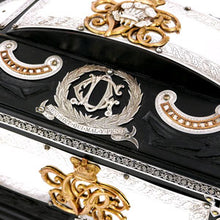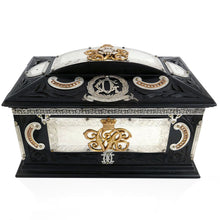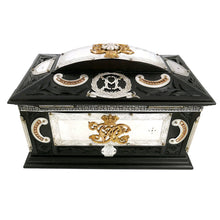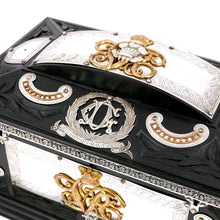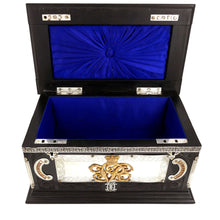13th Hussars - A Cavalry Officer’s Colonial Table Top Casket, 1880
Adding product to your cart
20.3cm (8in) x 30.4cm (12in) x 19cm (7.5in)
Ebony, silver and gilt brass. An Indian casket of rectangular form applied with elements of General John Miller’s uniform accoutrements; the hinged lid with arched central panel applied with his 3rd (Prince of Wales's) Dragoon Guards silver pouch flap; the forward chamfered edge applied with ‘Waterloo’ battle honour scrolls from the General’s 13th Hussars pouch belt flanking a bespoke openwork silver mount ‘DG’ for Dragoon Guards, encircled by a wreath and the Garter motto ‘Honi Soit Qui Mal Y Pense’ (Shame on him who thinks badly of it); the rear chamfered edge similarly applied openwork ‘M’ monogram for Miller encircled by a wreath and the 13th Hussar motto ‘Viret in aeternum’ (It Flourishes Forever) between ‘Peninsula’ battle honour scrolls; the chamfered end sections applied with pouch belt silver buckle tips; the front and rear of the casket panels applied with 13th Hussar pouch flaps and battle honour scrolls ‘Balaclava’ and ‘Inkerman’; the sides applied with silver belt slides hallmarked 1872 and 1878 and the battle honours ‘Sevastopol’ and ‘Alma’; the front panel additionally bearing a silver plaque engraved with the arms of General Miller. Silk lined interior and fitted with working twin four lever locks.
Read more
Major-General John Miller (1824-1911) served much of his career in India, rising by merit rather than purchase. He was commissioned Ensign without purchase in the 77th Foot in 1840 and transferred to in the 10th (North Lincoln) Regiment on their departure for India in 1842. In February 1846 he was present with his regiment at Sobroan, the decisive battle of the First Anglo-Sikh War. In June 1857 he was transferred from half-pay to be Captain in the 3rd Dragoon Guards (Prince of Wales’s) without purchase following that regiment’s arrival in India during the Sepoy Mutiny and rebellion in Bengal. The 3rd D.G. served in the Central India Field Force but Miller does not appear to have been with it. In 1868 he embarked with the regiment on the Abyssinian Expedition, led by General Robert Napier against the Ethiopian ruler Theodore II. Here Miller commanded the cavalry outposts on the Bashilo river at the storming of Magdala, for which he was mentioned in despatches and received the Brevet of Lt-Colonel. In 1874 he was appointed to the command of the 13th Hussars on its exchange of postings with the 21st Hussars. The 13th had been in Canada and had a strength of 450 all ranks. They landed at Bombay and travelled by train to join the Lucknow garrison, taking over the horses that the 21st Hussars had left in India. On 12 January 1876 the 13th Hussars were inspected with Miller at their head by the Prince of Wales during his Indian Tour of 1875-76. In January 1877 Miller took part in the mass review of troops at Delhi that accompanied the Imperial Assemblage - by which the Viceroy Lord Lytton formally declared Queen Victoria Empress of India to the Indian Princes with the utmost pomp and magnificence. On this occasion Miller led the 1st Cavalry Brigade comprising the 10th Hussars, 4th Bengal Cavalry, 10th Bengal Cavalry and 2nd Punjab Cavalry.






